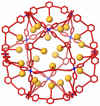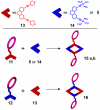Coordination-driven self-assembly of functionalized supramolecular metallacycles
- PMID: 19030534
- PMCID: PMC2621066
- DOI: 10.1039/b811712h
Coordination-driven self-assembly of functionalized supramolecular metallacycles
Abstract
Coordination-driven self-assembly that combines rigid ditopic Pt(II) metal acceptors and bis-pyridyl organic donors provides a facile means of synthesizing well-defined metallacycles of predetermined size and geometry. Functionalization of the component acceptor or donor building blocks allows for the preparation of multifunctional supramolecular materials wherein the stoichiometry and position of individual functional moieties can be precisely controlled. The design, self-assembly, and applications of polyfunctional supramolecules incorporating functional moieties with host-guest, photonic, materials, and self-organizational properties is discussed.
Figures












References
-
- Feynman RP. Engineering and Science. 1960:22.
-
- Kekulé Aug. Annalen der Chemi und Pharmacie. 1857;104:129.
-
- Kekulé Aug. Bulletin de la Societe Chimique de Paris. 1865;3:98.
- Kekulé Aug. Annalen der Chemie und Pharmacie. 1866;137:129.
-
- Zewail AH. Angew. Chem. Int. Ed. 1999;39:2586. - PubMed
- Zewail AH. J. Phys. Chem. A. 2000;104:5660.
Publication types
MeSH terms
Substances
Grants and funding
LinkOut - more resources
Full Text Sources
Other Literature Sources
Miscellaneous

